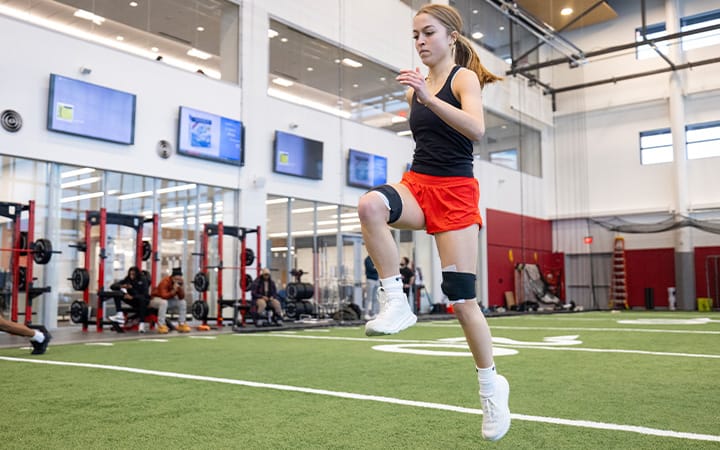The Rise of Wearables: Smarter, Safer Workouts for Everyone
July 24, 2025

One of the biggest advances in recent years is the growing use of wearable technology for athletes and everyday people alike. Wearable devices like smartwatches and other sensors can help people stay safe while exercising, improve their performance and enhance injury recovery.
James Voos, MD, University Hospitals Chairman of Orthopedics and head team physician for the Cleveland Browns, says advances in wearable technology have the potential to help active people of every caliber – from professional to “weekend warriors” – exercise smarter and safer.
What Is Wearable Technology?
Wearable technology or “wearables” refers to electronic sensors that collect and interpret data about your body in motion. Types of wearable tech include:
- Fitness trackers
- Smartwatches
- GPS trackers
- Motion sensors
- Heart rate monitors
- “Smart” clothing or shoes with embedded sensors
Depending on the device, wearables can measure vital signs such as heart rate and oxygen saturation levels, as well as metrics such as acceleration, speed, muscle strength, balance, stride and gait patterns.
One of the benefits of wearable tech is its ability to collect data about a person in real time – providing immediate feedback during physical activity for improved performance.
"Analyzing data after the fact is helpful for long-term planning, but real-time use of sensors and live input helps you perform better and more safely, " says Dr. Voos.
How Wearable Tech Can Improve Safety
As wearable technology gets more sophisticated and cost-effective, it’s becoming more practical for people to use it during training and recovery. It’s also an important tool in improving safety, says Dr. Voos.
Wearables that track real-time health data can help people determine if they need to take a break or decrease the intensity of their workout. And by monitoring things like heart rate, sensors can identify abnormalities that could indicate a health risk. Other applications include predicting injury risk and assessing recovery after an injury.
Predicting Injury Risk
"We believe sensors can be used to promote safety in sports,” says Dr. Voos. “Our focus has been on creating the safest environment for athletes. Immediate feedback for athletes and coaches from sensors can save athletes lives and help them stay in the game."
Movement sensors that use GPS technology can measure variables like energy used, position, impact and balance. By comparing data from different points in time, researchers have found that a sudden increase in an athlete’s training workload may increase the rate of soft tissue injuries. This includes injuries such as sprains, strains and other damage to muscles, tendons and ligaments. This knowledge can help coaches and trainers develop player-specific training schedules that gradually increase in intensity over time, reducing the risk of injury.
Injury Recovery and Return-to-Play
Another application for wearable technology is determining when an injured person can safely return to physical activity. By comparing pre- and post-injury performance metrics, physicians and trainers can help players develop training loads that will reduce the risk of re-injury. The data can also help identify patients who may need additional support during recovery, such as extra physical therapy sessions, before restarting their training regimen.
Orthopedic surgeons are also using wearable technology to gauge how patients are recovering from surgery after a sports-related injury. For example, Dr. Voos’s research focuses on tracking how a person’s muscles use oxygen after ACL surgery through sensors attached to the knee. The data collected with such sensors can provide valuable insight into a patient’s post-surgery journey, leading to safer and faster recoveries.
Technology That’s Accessible
Not only are the applications for wearable tech greater than ever, it’s also becoming an increasingly accessible and affordable tool for everyday athletes, says Dr. Voos. Once only available to professional and elite athletes, now anyone who is looking to improve their performance or gain a competitive edge can take advantage of wearables. With the knowledge they provide about your body, wearables can help you train safer and more efficiently while you work to improve your performance.
Related Links
The sports medicine specialists at UH Drusinsky Sports Medicine Institute provide athletes of all ages and skill levels with the tools and medical support they need to reach their fitness goals.


